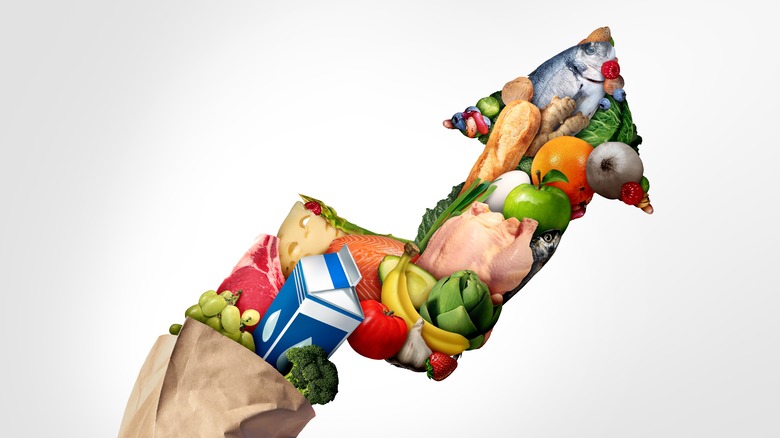The Unexpected Way Food Shoppers Are Reacting To Inflation
Food prices have been rising steadily since the beginning of the COVID-19 pandemic in early 2020 (via Reuters). Shuttered manufacturing and supply chain problems increased global demand and shortages came quickly after, with problems continuing to persist into 2021. And with Russia's invasion of Ukraine, a slow escalation turned into an all-out crisis because both countries are responsible for huge contributions to the global food chain. Russia is a huge exporter of fuel and fertilizers, and both are responsible for nearly a third of the world's wheat supply.
According to the U.S. Bureau of Labor Statistics (BLS), the price of "food at home" rose by 11.9% in the last 12 months, which is the largest increase of its kind since 1979, per Successful Farming.
Rising costs have shifted consumer's shopping habits as well. Many have opted for cheaper store brands over those that they normally trusted, restaurants are offering discounts to maintain customer loyalty, and more consumers are seeking out big box stores like Sam's Club and Costco to make the most out of fewer trips to the store.
There's also been another change in consumer habits that has analysts scratching their heads.
Consumers are changing where they shop
According to a review of shopper transaction data conducted by Symphony RetailAI, more shoppers are shying away from their usual grocery store for a more wallet-friendly alternative (via Food Dive). Symphony RetailAI head of analytics and HQ client delivery Josh McCann notes that in the past, consumers would opt for smaller package sizes and more affordable alternatives to their usual foods to save on groceries. McCann says the data hasn't shown that trend occurring as much with this crisis, and instead found consumers are shifting where they shop as much as how they shop.
"Mainstream grocery is losing these consumers faster than they can replace them," McCann told Food Dive.
Symphony Retail AI conducted their study by surveying 550 million transactions across 57 million North American and European households. McCann also noted that increased media savviness has allowed customers to easily shop around and compare prices between different retailers. This may be a contributing factor to this consumer trend.
According to McKinsey & Company, customer loyalty was devastated by the 2020 pandemic. They note that 75% of U.S. consumers tried a new shopping behavior in the pandemic's wake. Consumers are even more open than ever before to hunting for deals and affordable groceries.

